Potrebujeme váš súhlas na využitie jednotlivých dát, aby sa vám okrem iného mohli ukazovať informácie týkajúce sa vašich záujmov. Súhlas udelíte kliknutím na tlačidlo „OK“.
ASTM D7590-09(2014)
Standard Guide for Measurement of Remaining Primary Antioxidant Content In In-Service Industrial Lubricating Oils by Linear Sweep Voltammetry
Automaticky preložený názov:
Štandardné Príručka pre meranie Zvyšné základné obsahom antioxidantov In-Servis priemyselných mazacích olejov Linear Sweep voltametria
NORMA vydaná dňa 1.5.2014
Informácie o norme:
Označenie normy: ASTM D7590-09(2014)
Poznámka: NEPLATNÁ
Dátum vydania normy: 1.5.2014
Kód tovaru: NS-38782
Počet strán: 14
Približná hmotnosť: 42 g (0.09 libier)
Krajina: Americká technická norma
Kategória: Technické normy ASTM
Kategórie - podobné normy:
Anotácia textu normy ASTM D7590-09(2014) :
Keywords:
2,6-di-tert-butylphenol, 2,6-di-tert-butyl-4methylphenol, phenyl alpha naphthylamine, alkylated diphenylamine, turbine oil, linear sweep voltammetry (LSV), hindered phenol antioxidant, aromatic amine antioxidant, zinc dialkyl dithiophosphates, ICS Number Code 75.100 (Lubricants, industrial oils and related products)
Doplňujúce informácie
| Significance and Use | ||||||||||||||||||
|
5.1 The quantitative determination of remaining antioxidants for in-service industrial oils by measuring the amount of these additives that have been added to the oil as protection against oxidation. Industrial lubricants, such as turbine oils, compressor oils, gear oils, hydraulic oils, bearing lubricants and greases can be formulated with a wide variety of antioxidants types such as phenols and amines (as primary antioxidants), which are working synergistically and therefore all important to be monitored individually. For in-service oils, the LSV determines and compares the amount of original primary antioxidants remaining after oxidation have reduced its initial concentration. 5.2 This guide covers procedures for primary antioxidants such as amines and phenols, as described by Test Method D6971 and D6810. 5.3 LSV is not designed or intended to detect all of the antioxidant intermediates formed during the thermal and oxidative stressing of the oils, which are recognized as having some contribution to the remaining useful life of the used or in-service oil. In order to measure the overall stability of an oil (including contribution of intermediates present), and before making final judgment on the remaining useful life of the used oil (which might result in the replacement of the oil reservoir), it is advised to perform additional analytical techniques (in accordance with Practice D4378 and Practice D6224). 5.4 This guide is applicable to a wide range of industrial oils, both mineral or synthetic based, which can contain rust and oxidation inhibitors, antiwear additives such as zinc dialkyl dithiophosphates on gear oils, circulating oils, transmission oils and other industrial lubricating oils. 5.5 The test is also suitable for manufacturing control and specification acceptance. 5.6 When a voltammetric analysis is obtained for a industrial lubricant inhibited with at least one type of antioxidant, there is an increase in the current of the produced voltammogram between 5 to 8 s (or 0.5 to 0.8 V applied voltage) (see Note 1) for the zinc dialkyl dithiophosphate type of antioxidant (Fig. 1), an increase in the current of the produced voltammogram between 8 to 12 s (or 0.8 to 1.2 V applied voltage) (Fig. 2) (see Note 1) for the aromatic amines, and increase in the current of the produced voltammogram between 13 and 16 s (or 1.3 to 1.6 V applied voltage) (see Note 1) for the hindered phenols or carbamates in the neutral acetone solution (Fig. 2: x-axis 1 s = 0.1 V), or both. Hindered phenol antioxidants detected by voltammetric analysis include, but are not limited to, 2,6-di-tert -butyl-4-methylphenol; 2,6-di-Note 1: Voltages listed with respect to reference electrode. The voltammograms shown in Figs. 1-6 were obtained with a platinum reference electrode and a voltage scan rate of 0.1 V/s. 5.7 For industrial lubricants containing zinc dialkyl dithiophosphate type of antioxidants, there is an increase in the current of the produced voltammogram between 5 to 8 s (or 0.5 to 0.8 V applied voltage) (see Note 1) by using the neutral acetone test solution ( see Fig. 1). There is no corresponding ASTM International standard describing the test method procedures for measuring zinc dialkyl dithiophosphates type of antioxidants in industrial lubricants. 5.8 For industrial lubricants containing only aromatic amines as antioxidants, there is an increase in the current of the produced voltammogram between 8 to 12 s (or 0.8 to 1.2 V applied voltage) (see Note 1) for the aromatic amines, by using the neutral acetone test solution (first peak in Fig. 2) as described in Test Method D6971. 5.9 For industrial lubricants containing only hindered phenolic antioxidants, it is preferable to use a basic alcohol solution rather than the neutral acetone solutions, to achieve an increase in the current of the produced voltammogram between 3 to 6 s (or 0.3 to 0.6 V applied voltage) (see Note 1) in basic alcohol solution (Fig. 3: x-axis 1 s = 0.1 V) as described in Test Method D6810. |
||||||||||||||||||
| 1. Scope | ||||||||||||||||||
|
1.1 This guide covers the voltammetric analysis for qualitative measurements of primary antioxidants in new or in-service type industrial lubricants detectable in concentrations as low as 0.0075 mass percent up to concentrations found in new oils by measuring the amount of current flow at a specified voltage in the produced voltammogram. 1.2 This guide can be used as a resource for a condition monitoring program to track the oxidative health of a range of industrial lubricants which contain primary antioxidants. In order to avoid excessive degradation of the base-oil, these primary antioxidants play a major role to protect the lubricants against thermal-oxidative degradation. This guide can help users with interpretation and troubleshooting results obtained using linear sweep voltammetry (LSV). 1.3 When used as part of oil condition monitoring practices, it is important to apply trend analysis to monitor the antioxidant depletion rate relative to a baseline sample rather than use voltammetry for an absolute measurement of the antioxidant concentration. The trending pattern provides a proactive means to identify the level of oil degradation or abnormal changes in the condition of the in-service lubricant. 1.4 The values stated in SI units are to be regarded as standard. No other units of measurement are included in this standard. 1.5 This standard does not purport to address all of the safety concerns, if any, associated with its use. It is the responsibility of the user of this standard to establish appropriate safety and health practices and determine the applicability of regulatory limitations prior to use. |
||||||||||||||||||
| 2. Referenced Documents | ||||||||||||||||||
|
Podobné normy:
Historická
1.12.2011
Historická
1.6.2014
Historická
15.6.2013
Historická
1.8.2010
Historická
1.7.2010
Historická
1.10.2010



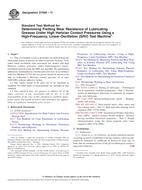 ASTM D7594-11
ASTM D7594-11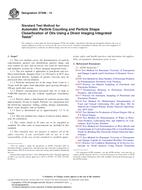 ASTM D7596-14
ASTM D7596-14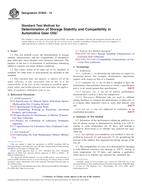 ASTM D7603-13
ASTM D7603-13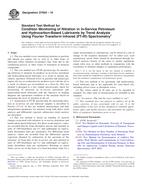 ASTM D7624-10
ASTM D7624-10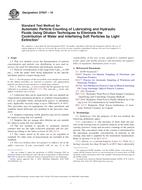 ASTM D7647-10
ASTM D7647-10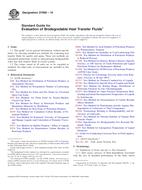 ASTM D7665-10
ASTM D7665-10
 Cookies
Cookies
